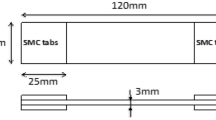Abstract
Fatigue damage of short glass fiber-reinforced composite is a quite complex phenomenon, and a large research effort is being spent on it these days. Furthermore, fatigue damage in such materials, fatigue damage kinetic exhibits three stages, namely: (i) matrix microcracking and damage initiation, (ii) coalescence and propagation of microcracks and (iii) macroscopic cracks propagation up to material failure. The proposed model is based on the stiffness degradation rule of short glass fibers-reinforced polyamide 66. This new versatile phenomenological fatigue damage model attempts to predict fatigue damage growth in its three stages. The characteristics of damage growth and accumulation of short glass fiber-reinforced polyamide 66 under fatigue bending loading were studied in this paper. Experimental data from bending fatigue tests were used to identify the model parameters. Results showed that this model is capable of describing the three stages of damage evolution of theses composite materials. Furthermore, the predicted fatigue life is in good agreement with the experimental ones.
Access this chapter
Tax calculation will be finalised at checkout
Purchases are for personal use only
Similar content being viewed by others
References
Atidel G, Saintier N, Dhiab A, Dammak F (2011) Etude du comportement mécanique d’un polyamide 66 chargé de fibres de verre courtes. Mécanique & Industrie 12(5):333–342
Benaceur I, Othman R, Guegan P, Dhieb A, Damek F (2008) Sensitivity of the flow stress of nylon 6 and nylon 66 to strain-rate. Int J Mod Phys B 22(9–11):1249–1254
Chebbi E, Wali M, Dammak F (2016a) An anisotropic hyperelastic constitutive model for short glass fiber reinforced polyamide. Int J Eng Sci 106:262–272
Chebbi E, Mars J, Wali M, Dammak F (2016b) Fatigue behavior of short glass fiber reinforced polyamide 66: experimental study and fatigue damage modelling. Period Polytech Mech 60:247–255
Epaarachchi JA, Clausen PD (2005) A new cumulative fatigue damage model for glassfibre reinforced plastic composites under step/discrete loading. Compos A 36:1236–1245
Esmaeillou B, Ferreira P, Bellenger V, Tcharkhtchi A (2012) Fatigue behavior of polyamide 66/glass fiber under various kinds of applied load. Polym Compos 33:540–547
Gu Y, Yao W (1999) Residual strength of fiber-reinforced plastics under fatigue loading. Acta Mater Compos Sin 16:98–102
Kachanov ML (1958) Time of the rupture process under creep conditions. TVZ Akad Nauk SSR Otd Tech Nauk 8:26–31
Kawai M (2004) A phenomenological model for off-axis fatigue behavior of unidirectional polymer matrix composites under different stress ratios. Compos A 35:955–963
Ladevèze P, Le Dantec E (1992) Damage modelling of the elementary ply for laminated composites. Compos Sci Tech 43:257–267
Lemaitre L, Chaboche JL (1990) Mechanics of solid materials. Cambridge University Press, London
Liu B, Lessard LB (1994) Fatigue and damage tolerance analysis of composite laminates: stiffness loss damage modeling and life prediction. Compos Sci Technol 51:43–51
Mao H, Mahadevan S (2002) Fatigue damage modeling of composite materials. Compos Struct 58:405–410
Nouri H, Meraghni F, Lory P (2009) Fatigue damage model for injectionmolded short glass fiber reinforced thermoplastics. Int J Fatigue 31:934–942
Poursartip A, Ashby MF, Beaumont PWR (1986) The fatigue damage mechanics of a carbon fiber composite laminate: I-Development of the model. Compos Sci Tech 25:193–218
Reifsnider KL, Henneke EG, Stinchcomb WW, Duke JC (1983) Damage mechanics and NDE of composite laminates. In: Hashin Z, Herakovich CT (Recent advances) (eds) Mechanics of composite materials. Pergamon Press, New York, pp 399–420
Sedrakian A, Ben Zineb T, Billoet JL (2002) Contribution of industrial composite parts to fatigue behavior simulation. Int J Fatigue 24:307–318
Sidoroff F, Subagio B (1987) Fatigue damage modelling of composite materials from bending tests. In: Matthews FL, Buskell NCR, Hodgkinson JM, Morton J (eds). Sixth international conference on composite materials (ICCM-VI) and second European conference on composite materials (ECCM-II), vol 4. Proceedings, 20–24 July, London, UK, Elsevier, pp 4.32–4.39
Subramanian S, Reifsnider KL, Stinchcomb WW (1995) A cumulative damage model to predict the fatigue life of composite laminates including the effect of a fiber matrix interphase. Int J Fatigue 17:343–351
Taheri-Behrooz F, Shokrieh MM, Lessard LB (2008) Residual stiffness in cross-ply laminates subjected to cyclic loading. Compos Struct 85:205–212
Van Paepegem W, Degrieck J (2001) Experimental setup for and numerical modelling of bending fatigue experiments on plain woven glass/epoxy composites. Compos Struct 51:1–8
Zhai H, Yao W (2002) A survey on stiffness reduction models of fiber reinforced plastics under cyclic loading. Adv Mech 32:69–80
Author information
Authors and Affiliations
Corresponding author
Editor information
Editors and Affiliations
Rights and permissions
Copyright information
© 2018 Springer International Publishing AG
About this paper
Cite this paper
Chebbi, E., Mars, J., Hentati, H., Wali, M., Dammak, F. (2018). A New Cumulative Fatigue Damage Model for Short Glass Fiber-Reinforced Polyamide 66. In: Haddar, M., Chaari, F., Benamara, A., Chouchane, M., Karra, C., Aifaoui, N. (eds) Design and Modeling of Mechanical Systems—III. CMSM 2017. Lecture Notes in Mechanical Engineering. Springer, Cham. https://doi.org/10.1007/978-3-319-66697-6_23
Download citation
DOI: https://doi.org/10.1007/978-3-319-66697-6_23
Published:
Publisher Name: Springer, Cham
Print ISBN: 978-3-319-66696-9
Online ISBN: 978-3-319-66697-6
eBook Packages: EngineeringEngineering (R0)




